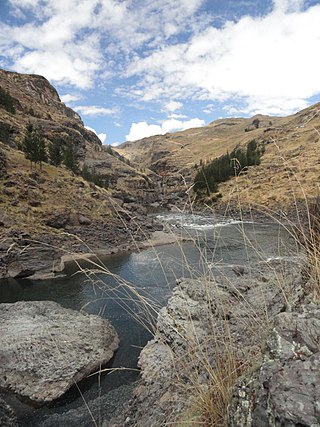Related Research Articles

Puno is a city in southeastern Peru, located on the shore of Lake Titicaca. It is the capital city of the Puno Region and the Puno Province with a population of approximately 140,839. The city was established in 1668 by viceroy Pedro Antonio Fernández de Castro as capital of the province of Paucarcolla with the name San Juan Bautista de Puno. The name was later changed to San Carlos de Puno, in honor of king Charles II of Spain. Puno has several churches dating back from the colonial period; they were built to service the Spanish population and evangelize the natives.

Arequipa is a department and region in southwestern Peru. It is the sixth largest department in Peru, after Puno, Cuzco, Madre de Dios, Ucayali, and Loreto, its sixth most populous department, and its eleventh least densely populated department. It is bordered by the departments of Ica, Ayacucho, Apurímac and Cusco in the north, the Department of Puno in the east, the Department of Moquegua in the south, and the Pacific Ocean in the west. Its capital, also called Arequipa, is Peru's second-largest city.

Puno is a department and region in southeastern Peru. It is the fifth largest department in Peru, after Cuzco, Madre de Dios, Ucayali, and Loreto. It is bordered by Bolivia on the east, the departments of Madre de Dios on the north, Cusco and Arequipa on the west, Moquegua on the southwest, and Tacna on the south. Its capital is the city of Puno, which is located on Lake Titicaca in the geographical region known as the Altiplano or high sierra.

Puno is a province in the Puno Region, in southeastern Peru. It borders the provinces of Huancane, San Román, El Collao and the Moquegua Region's province of General Sánchez Cerro. Its capital is the city of Puno, which is located at the edge of Lake Titicaca, the world's highest navigable lake. It is the economic powerhouse of the region.

San Román is a province in the Puno Region of Peru. It borders the provinces of Lampa, Azángaro, Puno, Huancane, the Arequipa Province of the Arequipa Region and Moquegua Region's province of General Sánchez Cerro. Its capital is the city of Juliaca.
Cusco–Collao or Qusqu–Qullaw (Quechua) is a collective term used for Quechua dialects that have aspirated and ejective plosives, apparently borrowed from Aymaran languages. They include Cusco Quechua, Puno Quechua, North Bolivian Quechua, and South Bolivian Quechua. Together with Ayacucho Quechua, which is mutually intelligible, they form the Southern Quechua language.

Southern Quechua, or simply Quechua, is the most widely spoken of the major regional groupings of mutually intelligible dialects within the Quechua language family, with about 6.9 million speakers. It is also the most widely spoken indigenous language in the Americas. The term Southern Quechua refers to the Quechuan varieties spoken in regions of the Andes south of a line roughly east–west between the cities of Huancayo and Huancavelica in central Peru. It includes the Quechua varieties spoken in the regions of Ayacucho, Cusco and Puno in Peru, in much of Bolivia and parts of north-west Argentina. The most widely spoken varieties are Cusco, Ayacucho, Puno (Collao), and South Bolivian.

Canas Province is one of thirteen provinces in the Cusco Region in the southern highlands of Peru.

Quispicanchi Province is one of thirteen provinces in the Cusco Region in the southern highlands of Peru.

Carabaya Province is a province of the Puno Region located in the southern part of Peru. It is bounded on the north by the Madre de Dios Region, on the east by the Sandia Province, on the south by the provinces of Azángaro, Melgar and Putina and on the west by the Cusco Region. The capital of the province is the city of Macusani.
Corani is one of ten districts of the Carabaya Province in Peru.
San Antonio District or San Antonio de Esquilache District is one of fifteen districts of the Puno Province in the Puno Region of Peru.
Tiquillaca District is one of fifteen districts of the province Puno in Peru.

Cutimbo is an archaeological site with stone tombs (chullpa) and cave paintings in Peru.
Tupu Inka is an archaeological site in Peru. It is located in the Puno Region, Yunguyo Province, Unicachi District.
Intikancha is a mountain with an archaeological site of the same name in the Andes of Peru, about 4,400 metres (14,436 ft) high. It is located in the Puno Region, Lampa Province, Nicasio District, and in the San Román Province, Juliaca District.

Pukaqucha is a lake in the Puno Region in southern Peru. It is situated in the Lampa Province, Lampa District, east of Lampa.
Collpacaja is a mountain in the southern extensions of the Vilcanota mountain range in the Andes of Peru, about 5,000 metres (16,404 ft) high. The mountain is situated in the Puno Region, Melgar Province, Nuñoa District. Collpacaja lies south of the mountain Yanacocha. West of it there is a small lake named Quellhuacocha.
Surichata is a mountain in the Andes of southern Peru, about 4,800 metres (15,748 ft) high. It is situated in the Puno Region, Puno Province, on the border of the districts San Antonio and Pichacani. Surichata lies north of the mountain Kunturiri and northeast of Wankarani and Ninachiri.
Pukara is a mountain in the Andes of Peru, about 4,200-metre (13,800 ft) high, with an archaeological site on top. It is located in the Puno Region, Sandia Province, Patambuco District, southwest of Patambuco. The pre-Inca funerary site is also known as Trinchera. The place was declared a National Cultural Heritage by Resolución Directoral Nacional No. 296/INC-2003 by the National Institute of Culture. It consists of tombs, walls, houses, squares and tunnels.
References
- 1 2 Puno Quechua at Ethnologue (25th ed., 2022)
